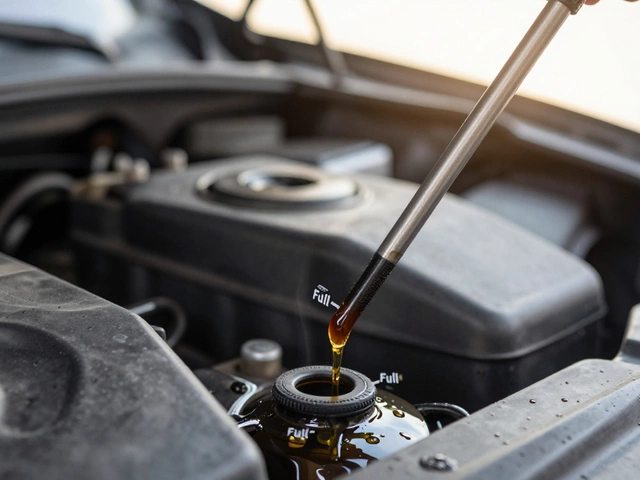
Ever been cruising down the road only to hear a strange clunking or rattling noise coming from your car? Well, there’s a good chance it's your struts trying to tell you something. Before you start imagining the worst-case scenario, let's break down what that unsettling noise might mean.
Struts are a key part of your car's suspension system, sitting quietly (or they should be!) and doing the heavy lifting to keep your ride smooth and steady. But when one goes loose, it starts to sound like a nut lost in a washing machine. Not the soundtrack you want on your morning commute, right?
The sounds can vary from annoying clunks to persistent rattles, often becoming louder when driving over bumps or making sharp turns. Why do these noises matter? Because ignoring them can lead to more significant problems down the road—not just with your car but with your wallet too.
Let’s dig into what a loose strut can do to your car's overall drive ability. Knowing the warning signs gives you a leg up in maintaining vehicle health, ensuring you don't end up stranded or worse.
- What's That Noise?
- Why Struts Matter
- Common Symptoms
- The Impact of Ignoring Struts
- DIY Checks
- When to Call a Pro
What's That Noise?
You've just started hearing a mysterious new sound while driving, and it's coming from beneath your car. At first, it's hard to place, but soon, it becomes a consistent part of your driving soundtrack. Could it be a loose strut?
One way to know for sure is by the type of noise it makes. A loose strut often results in a clunking or banging sound, especially when your vehicle hits a bump, pothole, or even during a routine corner turn. It’s similar to the sound of two solid objects knocking against each other, and trust me, it's not music to any driver's ears.
Why does a loose strut make such a racket? Inside a strut assembly, there’s a shock absorber surrounded by a coil spring. When it becomes loose, these components have a bit too much freedom to move around, causing that telltale noise as they bounce against each other or the car’s body.
Most folks notice the noise getting worse over time, starting softly and building as the problem persists. If you're hearing it more often, maybe even just driving on a flat road, the issue is definitely not going to fix itself. Ignoring the problem can hurt your car’s suspension system and make your steering less responsive—a downhill spiral you want to avoid.
Besides the clunking, pay attention to any changes in how the car handles. A struggling strut can all but guarantee a dip in driving performance, making your car feel less stable.
Need another clue? Check your tire wear. Uneven patterns on the tread might indicate a suspension issue, loose struts being a common culprit. Consider this a bonus tip to catch a problem before it escalates.
Knowing the noises your car shouldn't make can save you heaps of trouble in the long run. When in doubt, it's always smart to get those odd sounds checked professionally and promptly.
Why Struts Matter
Alright, so you're hearing that noise and wondering just how important these struts really are. Let me fill you in. Struts play a crucial role in connecting your vehicle's suspension system to the body. They’re like the unsung heroes that absorb all the shocks and bumps, giving you that smooth ride we all love. Without them, you’d feel every single bump in the road, and that's not a fun thought.
Struts aren't just there for comfort; they are essential for your safety too. They help keep your tires firmly planted on the road by controlling the vehicle's weight distribution. That means better grip and traction, which makes steering and braking way more effective. If your loose strut isn't taken care of, it can mess up alignment and increase wear on other suspension components, leading to pricey repairs.
Besides comfort and safety, struts also play into fuel efficiency. Yup, you might not think about it, but how your car's suspension functions can affect your miles per gallon. Efficient suspension components like struts help reduce the vehicle's weight transfer and drag, giving you a smoother and more efficient ride.
Want some numbers to back this up? Check this out:
| Condition | Impact on Fuel Efficiency |
|---|---|
| Well-Maintained Struts | Up to 3% improvement |
| Worn or Loose Struts | Reduced efficiency by up to 5% |
So, ignoring that clunking noise might not just be loud; it could be costly. Take the time to check out what your car is trying to tell you and those struts could save you from a headache down the road.
Common Symptoms
When dealing with car issues, spotting the symptoms early can be a total lifesaver. So, what are the telltale signs that your loose strut is crying out for attention? There's more to it than just noise; keep an eye (or ear) out for these common symptoms.
First up, that clunking or rattling sound. You'll usually hear it when you're riding over bumps or turning corners. It's like your car's way of nudging you saying, "Hey, something's off!" If the noise persists or worsens, don’t ignore it.
Another classic sign is uneven tire wear. If the tires on your vehicle are wearing out faster on one side, a loose strut might be the culprit. Your tires are trying to stick to the road, but struts that aren’t doing their job can mess with how the vehicle hugs the pavement.
Does your car seem to bounce more than usual? Excessive bouncing is another big red flag. It's like when you're on an old-school pogo stick; too much bounce can mean your struts aren't properly damping the motion.
Suspension noise isn’t just a sound problem; it can affect your steering too. If turning feels like more of a workout than it used to—even on flat surfaces—or your car pulls to one side, that could be the struts again.
As John Smith, an expert mechanic at CarFix Solutions, puts it:
"Listening to your car can tell you more than what a dashboard light ever will. Ignoring suspension noises is like trying to drive a car with your eyes shut."
- Clunking or rattling sounds over bumps
- Uneven tire wear
- Excessive vehicle bounce
- Tougher steering or pulling to one side
Tuning into these symptoms early can save you from hefty repair bills and keep your car operating smoothly. So, don’t shrug off those strange sounds and unusual behaviors—it’s your car’s way of letting you know something is up.

The Impact of Ignoring Struts
Thinking that weird noise is just going to disappear on its own? Probably not the best plan. A loose strut isn't just a minor inconvenience; it can actually mess with your car's performance in a big way. Sure, you might get used to the noise, but your car doesn't. Let's talk about what can go wrong when you turn a deaf ear to those sounds.
Firstly, ignoring a loose strut can totally wreck your car's alignment. When one part of your suspension is out of whack, everything else tries to adjust — often making the problem worse. This misalignment doesn't just cause uneven tire wear, which means more frequent tire replacements. Your tires and your wallet both take a hit.
Then there's the steering. Ever tried turning a shopping cart with a wonky wheel? It's kind of like that. A loose strut can make your steering feel sloppy, leading to less control on the road. Not exactly ideal when you're trying to avoid that pothole or make a tight turn.
Let's not forget safety. Your struts help keep your vehicle stable, so a problem with them can increase your stopping distance. That means in an emergency, your car might take longer to stop, putting you at risk for accidents. Yikes.
Financially speaking, small ignorance can lead to big expenses. What might start as a simple fix can turn into countless repairs when other parts start wearing out prematurely. So, addressing the rattling or clunking early on can save you a small fortune.
If you're not convinced yet, here's a little shocker: driving with faulty suspension parts can affect fuel efficiency. That constant battle with a loose strut makes your car work harder, meaning more trips to the gas station.
To sum it up, letting a loose strut do its noisy thing isn't really worth it. The sooner you give it the attention it needs, the smoother your ride will be — quite literally.
DIY Checks
So, you suspect you have a loose strut? Before you panic and call in the cavalry, you might want to roll up your sleeves and do a little investigation yourself. It’s not rocket science—just some practical steps to confirm your hunch.
First off, perform a visual inspection. With your car parked on a flat surface, take a close look at the struts. Check for any visible damage or leaks. If you spot oil, that’s a suspicious sign—struts should definitely not be crying oil slick tears.
Next, do the old bounce test. Push down hard on each corner of your car and then let go. You’re looking to see how it rebounds. If it bounces more than once or keeps bobbing up and down like a wild bobblehead, your struts might be compromised.
Don’t forget to listen! You want to pay attention to any clunking or rattling when you’re using your car normally, say when driving over bumps or making sharp turns. Noises here are key indicators of a suspension noise.
Now grab a flashlight and check the mounting hardware. These are nuts and bolts holding the strut in place. If you spot any loosening or rusted parts, it might be a good time to tighten things up or consider replacements.
If you're feeling adventurous, jack up the car securely—safety first, right?—and remove the tire for a better view of the strut assembly. Look for broken springs or any signs of evident wear.
- Push test to identify excess bouncing.
- Look for fluid leaks around the struts.
- Check for loose or rusty mounting hardware.
- Listen for unusual noises when driving.
These checks won’t turn you into a certified mechanic, but they can help you identify if the problem’s glaring or if it’s time to reach for the phone and call a pro. Remember, tackling a vehicle repair issue early can save a lot of stress and hard-earned cash down the road.
When to Call a Pro
Knowing when to throw in the towel and call a professional can save you from turning a small problem into a big headache. That loose strut you've been hearing clunk around is not something you want to ignore, especially if DIY solutions aren't your strong suit.
First, ask yourself a few questions. Have you noticed your car swaying or bouncing more than usual? Maybe it's dipping when you brake or making those rattling noise more frequently? If you're nodding your head, it might be time to hand it over to someone with a wrench and some real know-how.
Professionals have the right tools and the experience to diagnose not just the symptom, but the root issue. They’ll be able to assess whether that noise is due to worn out struts or if you've got something else going on down there.
If you're seeing warning signs like fluid leaks around the suspension parts or uneven tire wear, that’s another red flag. These are clear signals that your suspension system might need more than just a simple tweak. Ignoring these could lead to costlier repairs or even pose safety risks.
Oh, and don’t forget the alignment! Even a small issue like a loose strut can knock your car's alignment out of whack, affecting how it handles and causing uneven wear on your tires. A pro will make sure everything is in tip-top shape.
- Persistent noise when driving over bumpy roads.
- Swaying or bouncing of the car body.
- Visible wear on tires or leaking fluid.
Let’s be honest, sometimes it's better to let the pros handle it. You'll thank yourself later when that smooth ride returns and you're not having flashbacks to that haunted-house-style racket.





